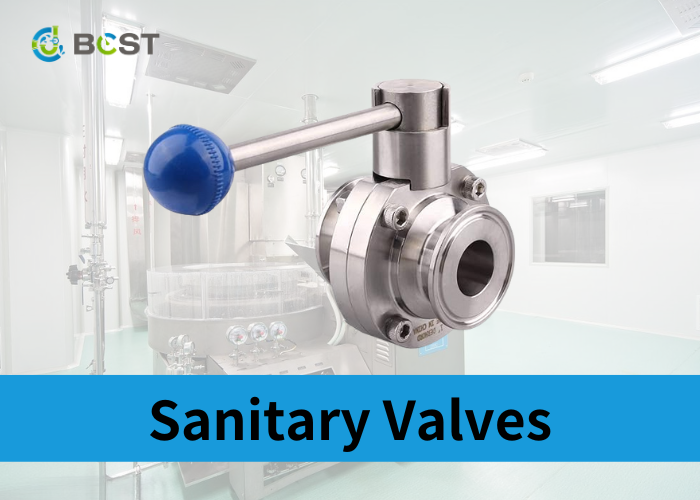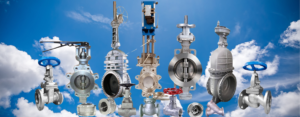
What is a Sanitary Valve?
Sanitary-grade valves are designed for applications that require high hygiene and cleanliness standards. Their major duty is to protect against cross-contamination, product spoiling, and the accompanying health hazards associated with unsanitary surroundings. Manual, pneumatic, electrical, or hydraulic control is available for these valves. They are capable of working with gases and liquids and liquids containing suspended particulates.

Design Features of Sanitary Valves
Sanitary grade valves are intended to reduce dead spots (areas where fluids stagnate), which can lead to bacterial development or product contamination. These valves frequently have streamlined bodies, flush-mounted connections, and no crevices or internal pockets that can trap fluid and impurities.
- Material Selection:In sanitary grade valves, material selection is vital to provide corrosion resistance, ease of cleaning using SIP and CIP techniques, compatibility with chemicals they interact, and high-temperature resistance. High temperatures in sterilizing processes such as autoclaving or steam cleaning should be tolerated by the materials.
Choosing suitable materials, such as stainless steel, alloys, or FDA-approved polymers, helps maintain the valves’ hygienic properties and prevents contamination risks.
- Surface Finish:The inside surfaces of sanitary grade valves are frequently polished to a high degree of smoothness to avoid particle and bacteria adherence. To guarantee optimal hygiene, they have precise surface-finish criteria. The Ra (Roughness Average) number, for example, specifies the amount of smoothness and cleanliness necessary for the valve’s surface. A lower Ra value suggests a smoother, easier-to-clean surface that is less prone to bacterial adhesion.
- Sealing:To prevent contamination, sanitary grade valves use high-quality seals. These seals are often composed of high-temperature and corrosion-resistant silicone, EPDM, or Viton.
- Electropolishing:To remove surface flaws and improve corrosion resistance, immerse the valve in an electrolyte bath and apply an electric current. Electropolished surfaces are smoother, more resistant to contamination, and easier to clean.
- Tri-clamp Connections:Tri-clamp connections, also known as tri-clover or tri-clover fittings, are commonly used in sanitary grade valves. These connections form a safe and sanitary seal between two components such as a valve and a pipe or a valve and a tank. Tri-clamp fittings are used in industries that require frequent sterilization because they are simple to construct, remove, and clean.
- Welding techniques: Sanitary grade valves often employ specialized welding techniques, such as orbital or sanitary TIG (Tungsten Inert Gas) welding. These techniques provide precise and consistent welds that do not introduce contaminants, thus ensuring the integrity and hygienic properties of the valve.
Advantages of sanitary ball valves
- Superior Hygiene Standards:Sanitary grade valves are designed to meet stringent cleanliness requirements. Their smooth surfaces and hygienic seals reduce the possibility of product contamination, ensuring the fluid’s integrity and safety.
- Traceability:Complete traceability (the ability to follow a product’s history, origin, materials, and movement throughout its lifecycle) of all components, including valves, is critical in particular industries, such as pharmaceuticals. Certain manufacturers supply this information for their sanitary grade valves, which customers can request when placing their order.
- SIP and CIP Compatibility:Sanitary grade valves are designed to be SIP (Steam-in-Place) and CIP (Clean-in-Place) compatible. SIP includes sterilizing the valve by exposing it to high-temperature steam. Cleaning solutions and circulation are used in CIP to eliminate pollutants. Sanitary grade valves’ design and materials allow them to endure these demanding cleaning and sterilizing treatments without affecting their integrity.
- Simple Cleaning and Maintenance:Sanitary grade valves are made to be simple to clean and maintain.
Sanitary-grade valves can be easily dismantled for cleaning. Some can even be cleaned without disassembly using the CIP technique.
The smooth surface facilitates thorough cleaning and minimizes the risk of bacterial growth.
Its construction allows for fast and efficient maintenance, reducing downtime and ensuring optimal performance.
- Regulatory Compliance:Sanitary grade valves should meet requirements such as 3A, FDA, and EHEDG.
- Versatile Options:Sanitary grade valves come in a variety of shapes and sizes, including butterfly valves, ball valves, diaphragm valves, check valves, and pressure relief valves, each with its own set of uses and benefits.
Disadvantage of Sanitary Valves
While sanitary valves play a crucial role in maintaining hygiene and purity in fluid handling systems, they are not without their drawbacks. Here are some disadvantages associated with sanitary valves:
- Cost:Sanitary valves often come with a higher initial cost compared to standard valves.
- Complex Maintenance:The intricate design of sanitary valves, with features such as polished surfaces and specialized seals, can make maintenance more complex. Regular disassembly, cleaning, and reassembly are necessary to prevent contamination, requiring additional time and expertise.
- Limited Material Options:Sanitary valves are typically manufactured from specific materials like stainless steel to meet stringent hygiene standards. This limited material selection may not be suitable for all process requirements, potentially restricting their applicability in certain industries or applications.
- Pressure Limitations:Some sanitary valves may have limitations regarding pressure handling capabilities compared to their non-sanitary counterparts. This can be a consideration in applications where high-pressure conditions are a critical factor.
- Flow Restriction:The design features that enhance cleanliness in sanitary valves, such as smooth surfaces and minimal dead space, can sometimes lead to increased flow resistance. This may impact the efficiency of the fluid handling system, particularly in situations where a high flow rate is essential.
- Specialized Expertise Required:Installation and maintenance of sanitary valves demand specialized knowledge and skills. This can lead to higher labor costs, as professionals with expertise in sanitary system components are often required for proper handling.
- Compatibility Challenges:In certain applications, achieving compatibility between different components, such as fittings and connectors, can be challenging. The need for uniformity in material and design across the entire system may limit flexibility in system configuration.
- Risk of Damage during Handling:Sanitary valves, with their polished surfaces and precision components, can be more susceptible to damage during handling and installation. Careful precautions must be taken to avoid scratches, dents, or other forms of damage that could compromise their effectiveness.
Despite these disadvantages, the benefits of maintaining sanitary conditions often outweigh the drawbacks, especially in industries where product purity and hygiene are of utmost importance. Careful consideration of these factors is essential when deciding whether to incorporate sanitary valves into a specific fluid handling system.

Applications of Sanitary Valves
- Water Treatment and Purification:Sanitary valves are used to control water flow in water treatment plants, ensuring clean and safe drinking water for communities.
- Food and Beverage:Sanitary valves are vital in food and beverage production to maintain hygiene and prevent contamination while making beverages, dairy products, sauces, and other consumables.
- Pharmaceutical and Biotech:Sanitary valves are essential in pharmaceutical and biotech processes where fluid purity and sterility are critical for drug development and research.
- Cosmetics and Personal Care Products:Sanitary valves are used in the cosmetics and personal care industries to precisely manage components during the creation of lotions, creams, and other personal care items.
- Chemical and Petrochemical: Sanitary valves are used in chemical and petrochemical processes, where corrosive or hazardous fluids must be controlled with maximum safety and cleanliness.






